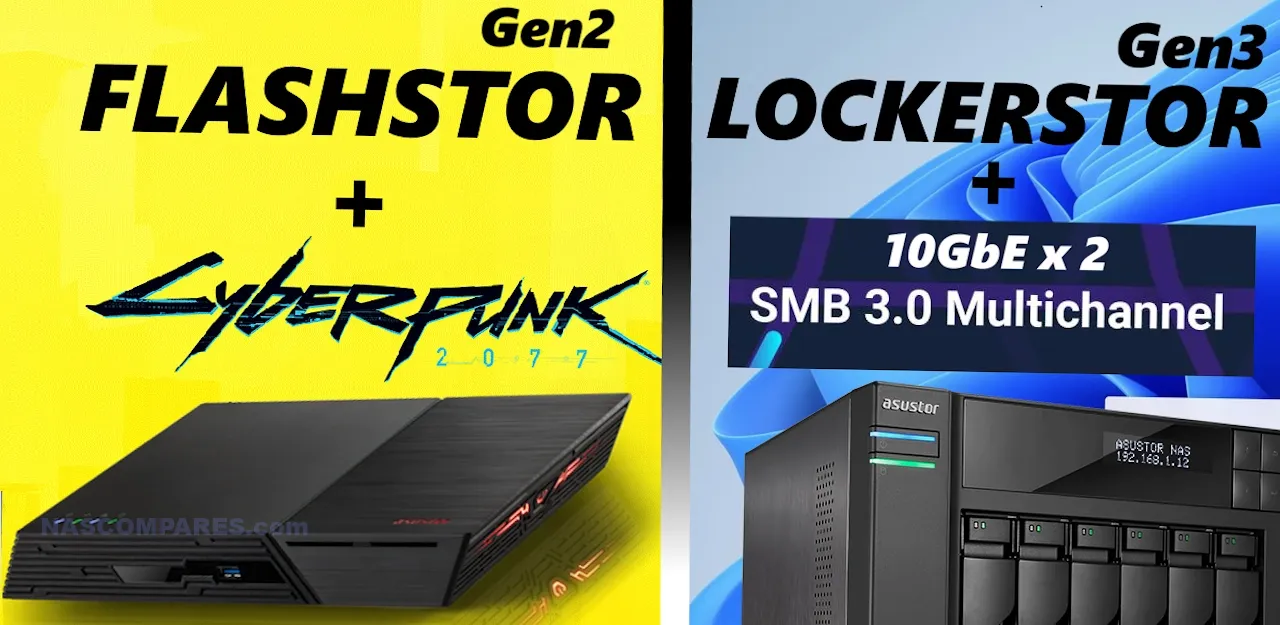The Flashstor Gen 2 NVMe NAS – Update on Performance, PCIe Lanes, Release, and More
*UPDATE* – The Flashstor Gen 2 is Now Released
Flashstor 6 Gen 2 (AS6806X) $999 – HERE
Flashstor 12 Pro Gen 2 (FS6812X) $1399 – HERE
Find Out More about them here – HERE on YouTube
In the two months or so since Asustor first announced the release of the new entry into their Flash NAS series, the Flashstor Gen 2, it has caused quite a buzz! This new 12x M.2 NVMe slot desktop NAS system effectively super-sizes everything we saw in the Gen 1 model but also adds dual 10GbE and ECC memory. Fast forward to now, and we got to spend some more time with the device at the Asustor stand at Computex 2024 (as well as the similarly profiled Lockerstor Gen 3) to learn more about what it can do, what it cannot do, and to explore more of its hardware profile.
Flashstor Gen 2 10GbE Performance
Asustor demoed the Flashstor and Lockerstor systems, connected to a Windows 11 PC over 2x 10GbE, using SMB Multichannel, and transferred 120GB of data. Both systems were able to fully saturate the dual 10GbE connection and, after accounting for the drag factors associated with this network protocol, achieved 1.8GB/s with sustained performance throughout.
Needless to say, this is still less than the total performance possible with the SSDs inside the Flashstor Gen 2, but it is a positive sign moving forward.
The PCIe Lanes of the M.2 inside the Flashstor Gen 2
This aspect was somewhat of a mixed bag when looking more closely at the architecture of the Flashstor Gen 2, as many people (myself included) were unsure how exactly Asustor would allocate lanes and speed across the 12x M.2 slots inside the system. The answer is… quite messily! We have to be fair here; the Flashstor Gen 2 is still a NAS that is mid-development and subject to change. However, the units on show at the event had the following breakdown of PCIe lanes/speeds detailed on its PCB and confirmed by the team:
How the 12x M.2 NVMe slots are broken down:
– Gen 4×4 = 1 Slot
– Gen 4×1 = 4 Slots
– Gen 4×2 = 3 Slots
– Gen 3×4 = 1 Slot
– Gen 3×2 = 1 Slot
– Gen 3×1 = 2 Slot
This is an unusually mixed arrangement inside a single device. Although there is a lot more performance bandwidth here compared to the 12x Gen 3×1 in the Flashstor Gen 1, there are questions about the system’s performance when creating RAID pools on the M.2 in the Gen 2 that span drives of different speeds. The reality is that most pool configurations, such as a RAID 5 or RAID 0 of drives, will have their performance capped per drive to the speed of the slowest drive in the array. For example, 12 drives in the Gen 4 and Gen 3 slots will be reduced from 2000MB/s per lane to 1000MB/s max; the same goes for x4 slots, x2 slots, and x1 slots.
At least they are trying their best to use up as much of the bandwidth as possible from that Ryzen CPU, but it is still an undeniably bizarre arrangement of slots inside a single NAS system.
PC Gaming and the Flashstor Gen 2 System
The last demo at the stand related to the Flashstor was the system connected to a modern PC system to show how the 2x 10G connections combined with the high performance and low latency of the M.2 SSDs in the Flashstor and Lockerstor. This was done by running the latest version of Cyberpunk 2077 from the NAS systems. The game was running from the gaming machine with its own GPU, etc., but the game’s data files from launch (Steam, Epic, etc.) were all running from the NAS.
There was no drop in frame rate, no poor texture pop-in, no unexpected load screens as you transitioned through the world, and no examples of poor texture swapping. Indeed, the game played like it was stored on the PC’s own storage—but it wasn’t; it was managing the game data from the Flashstor Gen 2’s storage. This was achieved using an iSCSI LUN created in the Asustor ADM Storage Manager and then mounted on the PC via the built-in Windows iSCSI initiator.
(Here is a clip from the video where the tests were shown):
Running games from a NAS system is not new, but as more games are being developed with M.2 NVMe SSD storage in mind, they are also getting bigger and bigger (notwithstanding ‘Game as a Service’ titles that will grow constantly over the years). If you have years and years of titles in your Steam library and are concerned they might one day be taken offline, you will need some serious storage to ensure you have it all! With the performance benefits of accessing multiple M.2 SSDs in a RAID configuration and the expanded storage potential of these systems compared with the limited number of M.2 slots in ma00ny systems, you can definitely see why there is a growing appeal for games to be played off a NAS.
*UPDATE* – The Flashstor Gen 2 is Now Released
Flashstor 6 Gen 2 (AS6806X) $999 – HERE
Flashstor 12 Pro Gen 2 (FS6812X) $1399 – HERE
Find Out More about them here – HERE on YouTube
The Flashstor is still a fair way from full release—even the name ‘Gen 2’ seems to be a matter still under debate. Last month, I recorded a User Q&A with a brand representative that covered all the questions users had about the Flashstor Gen 2 and Lockerstor Gen 3. You can watch the whole thing below in the video (chapters on the bar at the bottom)

